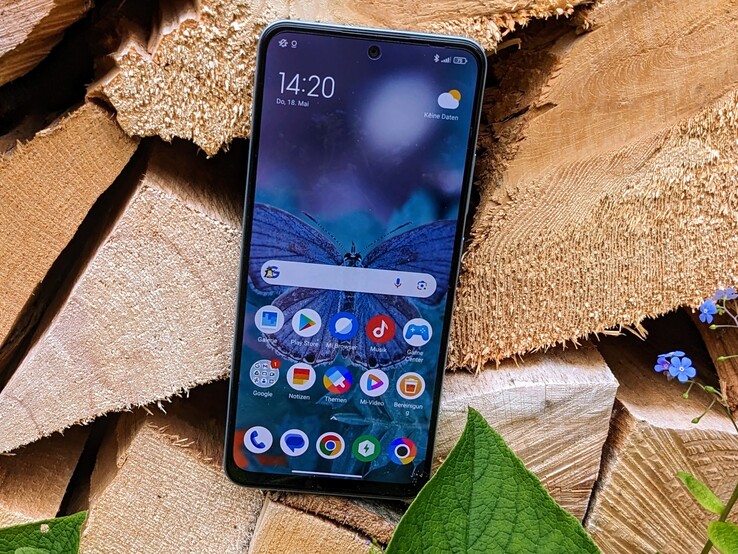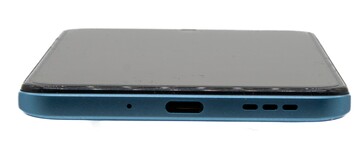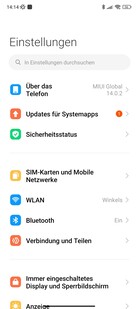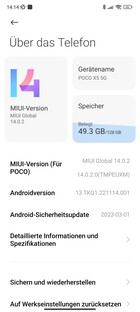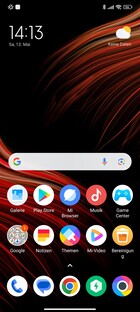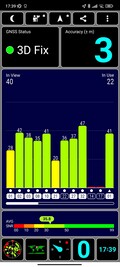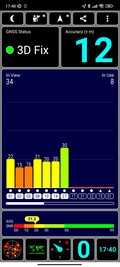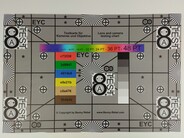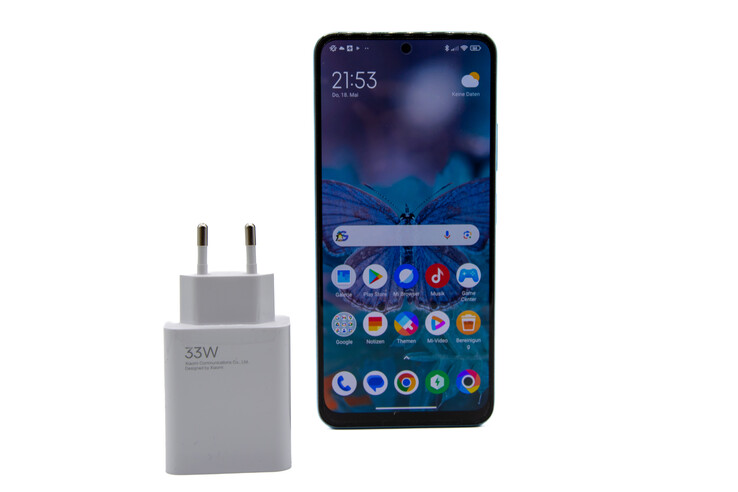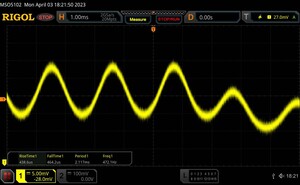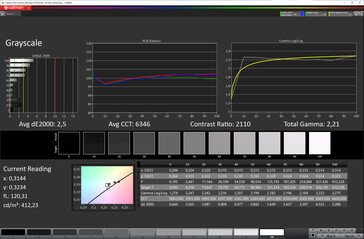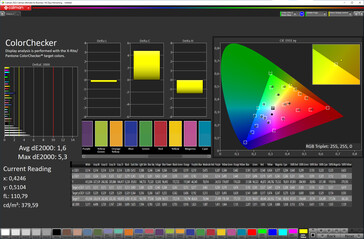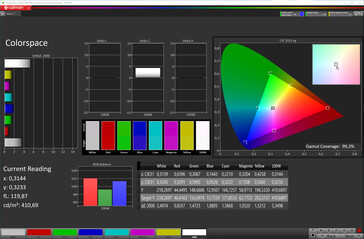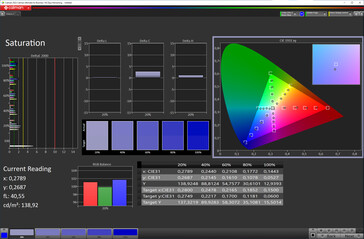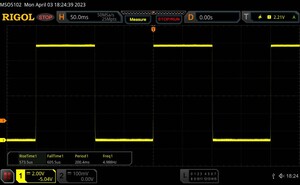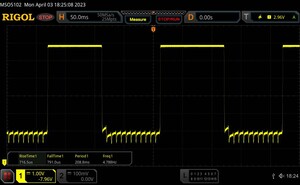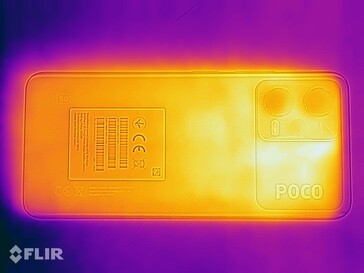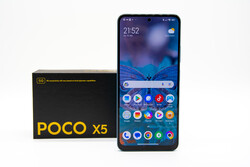Xiaomi Poco X5 smartphone review - Everything you need?
The Poco X5 is a mid-range device from Poco. It is above Poco's M series but below the F series. Next to the X5 5G, there is also a better-equipped X5 Pro 5G. Poco offers the X5 in different versions, either with 128 GB memory and 6 GB RAM or with 256 GB memory and 8 GB RAM.
The smaller model currently costs $226 and for more memory, you will be paying just under $50 extra. The X5 is available in three colors: black, blue and green. All the colors are relatively understated and matte. Our test model is the one with the smaller memory.
possible competitors compared
Rating | Date | Model | Weight | Drive | Size | Resolution | Price |
|---|---|---|---|---|---|---|---|
| 81.4 % v7 (old) | 05 / 2023 | Xiaomi Poco X5 SD 695 5G, Adreno 619 | 190 g | 128 GB UFS 2.2 Flash | 6.67" | 2400x1080 | |
| 80.3 % v7 (old) | 10 / 2022 | Samsung Galaxy A23 5G SD 695 5G, Adreno 619 | 197 g | 64 GB UFS 2.2 Flash | 6.60" | 2408x1080 | |
| 79.1 % v7 (old) | 03 / 2023 | Motorola Moto G53 SD 480+, Adreno 619 | 183 g | 128 GB UFS 2.1 Flash | 6.50" | 1600x720 | |
| 82 % v7 (old) | 05 / 2023 | Honor Magic5 Lite 5G SD 695 5G, Adreno 619 | 175 g | 128 GB UFS 2.2 Flash | 6.67" | 2400x1080 | |
| 80.1 % v7 (old) | 05 / 2023 | Xiaomi Redmi Note 12 4G SD 685, Adreno 610 | 188 g | 128 GB UFS 2.2 Flash | 6.67" | 2400x1080 | |
| 78.2 % v7 (old) | 04 / 2023 | Telekom T Phone Pro Dimensity 700, Mali-G57 MP2 | 215 g | 128 GB UFS 2.0 Flash | 6.82" | 1640x720 |
Case - The X5 is built well
The back of the Poco X5 is made of plastic. The camera module extrudes a little - if you type while the phone is on the table, it wobbles ever so slightly. Its build is good - the buttons have a clear pressure point. The phone is IP53 certified, meaning it is at least water-repellent. The frame and back are both matte and don't have a tendency to show fingerprints. The device makes noises when you try to twist it.
Features - The Poco X5 has NFC and a microSD
The Poco X5 relies on solid hardware. Its installed Snapdragon 695 5G isn't totally up-to-date, but this isn't any reason to shy away in this price category. A positive aspect is that the phone has an audio jack and that you can expand the storage via a microSD card. The device even has an infrared port and NFC.
The phone also has a dual SIM feature - but only when there is no microSD card installed, as it is a hybrid port. Its USB-C connection only has a USB 2.0 transmission standard.
microSD card reader
The Xiaomi Poco X5 has a built-in microSD card reader which accepts a capacity of up to 1 TB. The device is also exFAT capable. In our test using an Angelbird AV Pro V60 as a reference card, the phone's transfer rates were decent.
The X5 is a little faster than the Redmi Note 12 and considerably faster than the Telekom T-Phone Pro. However, the Samsung Galaxy A23 is about twice as fast when it comes to transferring data.
| SD Card Reader - average JPG Copy Test (av. of 3 runs) | |
| Samsung Galaxy A23 5G (Angelbird V60) | |
| Xiaomi Poco X5 (Angelbird AV Pro V60) | |
| Xiaomi Redmi Note 12 4G (Angelbird V60) | |
| Telekom T Phone Pro (Angelbird AV Pro V60) | |
Cross Platform Disk Test (CPDT)
Software - The X5 runs Android 13
The Poco X5 comes delivered with Android 12 installed - but directly after setting the phone up, it offers you the option to update it to Android 13. The manufacturer relies on MIUI 14 as an overlay. After first setting up the 128-GB version of the phone, there were 101 GB available to use. At the time of testing, the safety patch is from 1st March 2023.
Ex works, the phone comes with quite a few apps preinstalled - ranging from Poco apps and Xiaomi and Google software, all the way through to third-party apps such as TikTok, AliExpress, Booking, Amazon, Bing and Agoda. There are quite a few games already installed, too. Thankfully, all of these apps can easily be deleted.
Information regarding how long the Poco X5 will be supplied with software and security updates is not available at present.
Communication and GNSS - The X5 has stable transfer rates
The Poco phone uses Wifi-5 for its WLAN connection. Using the Asus ROG Rapture GT-AXE11000 as our reference router, transmission worked fine and the rates in our test remained stable. In terms of speed, the X5 is average for this price range. All the other phones in this comparison delivered similar speeds.
When it comes to cellular connection, the phone behaves just as unremarkably. It is capable of 5G, its coverage is good and all the most important frequency bands are covered.
Outside, the Poco X5 establishes a connection via satellite quickly and reliably. Indoors, the connection is a little less stable and its positioning is quite inaccurate. The Poco has a mono GNSS connection, but it supports SBAS.
We tested the satellite connection's accuracy on a bike trip using the Garmin Venus 2 as a reference device. The Poco X5 did a good job of localizing and it displayed radii well. In everyday use, navigation using services such as Google Maps should work without a problem.
Phoning and call quality - The Poco allows for clear conversations
There are no surprises when it comes to phoning on the Poco X5. The tone coming out of the earpiece is clear and loud enough. Your voice is transmitted reliably - although it could filter out background noise a little better. Phoning using the loudspeaker is fine, too. The maximum volume is sufficient - although the loudspeaker has a tendency to rattle a little bit.
Poco don't use their own telephone app - instead, they rely on Google software. The app is structured well and doesn't cause any confusion.
Cameras - The X5's main camera does the job
A triple camera can be found on the back of the Poco X5. Its main camera has a maximum resolution of 48 MPix - although, generally it uses a pixel binning method and the actual resolution is 12 MPix. You can use a separate mode to take photos using the full 48 MPix.
In good lighting conditions, the photos are nice. Its color depiction is natural - although, the photos could be a little sharper. There is a steep decline in sharpness in darker lighting conditions and the photos start to appear a little washed-out.
The ultra-wide angle lens yields much less sharp and detailed results. Upon closer inspection, the images are quite grainy and simply can't keep up with those taken using the main camera. The macro camera has a resolution of 2 MPix - photos taken with this lens are decent if there is enough light.
The X5 can record video on all lenses at a maximum of 1080p and 30 FPS. Video stabilization works fine - although, the images are sometimes quite washed-out and smudged.
Image comparison
Choose a scene and navigate within the first image. One click changes the position on touchscreens. One click on the zoomed-in image opens the original in a new window. The first image shows the scaled photograph of the test device.
Main camera rabbitLakeUltra-wide angle lens5x ZoomLow-lightIn controlled lighting conditions, the X5 delivers sharp photos - in the middle as well as the edges. With less light (1 lux), you can still see some detail, but the images suffer from quite a bit of noise.
Color depiction is fine in controlled lighting conditions - but photos have a tendency to be depicted a little too light. This is most noticeable with darker green tones.
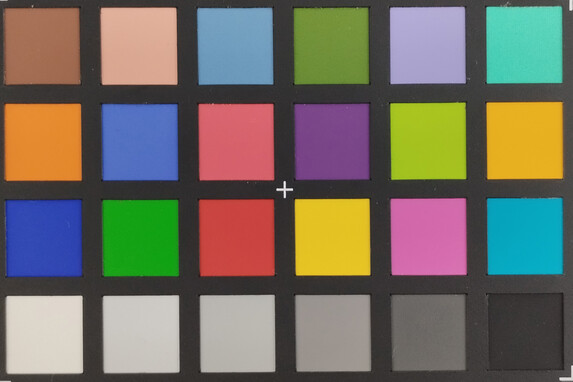

Accessories and warranty - Poco have included a 33-watt power supply
Not only does the Poco X5 come with a USB cable (USB-A to USB-C), but it also comes with a fitting 33-watt power supply. The package also includes an instruction manual, a SIM eject tool as well as a transparent case. Ex works, the phone's screen is also fitted with a screen protector.
In Germany (where this review was conducted), the Poco X5 comes with a two-year warranty.
Input devices & operation - The X5 unlocks at lightning speed
Poco have gone for Google's GBoard keyboard for this phone, which means that typing feels smooth and you don't have to worry about many wrong inputs. Even with the screen protector, the screen has a nice gliding feel to it. Touch inputs are reliably recognized - even toward the corners of the screen.
The X5 can be unlocked using its fingerprint scanner in the power button, but you can also do this via 2D facial recognition. Both methods work really quickly and reliably - the X5 can be unlocked at lightning speed every time.
A one-handed mode is integrated into the MIUI, which also works every time and makes using the phone with one hand an enjoyable experience.
Display - A brightness of over 1,000 nits and 120 Hz
The X5's display is 6.67 inches in size and has a ratio of 20:9. Its AMOLED panel allows for a refresh rate of up to 120 Hz. Poco advertize the phone as having a maximum brightness of 1,200 nits. In our realistic APL 18 test, we weren't quite able to reach these numbers - but at 1,035 cd/m², the screen is still nice and bright. This number was achieved with activated ambient light sensor - without this sensor, we achieved a maximum of 432 cd/m².
Compared to other devices in this class, the Poco X5 sure wins some points. Only the new Honor Magic5 Lite managed higher brightness levels and had slightly more accurate colors. Compared its other competitors, the Poco is miles ahead.
However, at 120 Hz, our measurements also showed a constant PWM from a brightness of 54 per cent - presumably this is an OLED flicker. At lower brightness levels, this flickering fluctuated between 151 and 486 Hz.
The X5's settings do offer an option for an always-on display, but it isn't a true AOD. The display can be customized, but it isn't always on - instead, it shows this for a few minutes before the screen completely switches off.
| |||||||||||||||||||||||||
Brightness Distribution: 98 %
Center on Battery: 674 cd/m²
Contrast: ∞:1 (Black: 0 cd/m²)
ΔE ColorChecker Calman: 1.6 | ∀{0.5-29.43 Ø4.83}
ΔE Greyscale Calman: 2.5 | ∀{0.09-98 Ø5.1}
99.3% sRGB (Calman 2D)
Gamma: 2.21
CCT: 6346 K
| Xiaomi Poco X5 AMOLED, 2400x1080, 6.7" | Samsung Galaxy A23 5G PLS, 2408x1080, 6.6" | Motorola Moto G53 IPS, 1600x720, 6.5" | Honor Magic5 Lite 5G AMOLED, 2400x1080, 6.7" | Xiaomi Redmi Note 12 4G AMOLED, 2400x1080, 6.7" | Telekom T Phone Pro IPS, 1640x720, 6.8" | |
|---|---|---|---|---|---|---|
| Screen | -102% | -23% | 24% | 12% | -96% | |
| Brightness middle | 674 | 447 -34% | 587 -13% | 846 26% | 650 -4% | 436 -35% |
| Brightness | 683 | 428 -37% | 559 -18% | 853 25% | 658 -4% | 392 -43% |
| Brightness Distribution | 98 | 86 -12% | 91 -7% | 88 -10% | 97 -1% | 85 -13% |
| Black Level * | 0.31 | 0.4 | 0.28 | |||
| Colorchecker dE 2000 * | 1.6 | 5.54 -246% | 2.6 -63% | 1.3 19% | 1.55 3% | 5.2 -225% |
| Colorchecker dE 2000 max. * | 5.3 | 10.04 -89% | 5.62 -6% | 2.7 49% | 2.59 51% | 9.5 -79% |
| Greyscale dE 2000 * | 2.5 | 7.3 -192% | 3.3 -32% | 1.7 32% | 1.8 28% | 7 -180% |
| Gamma | 2.21 100% | 2.03 108% | 2.463 89% | 2.19 100% | 2.194 100% | 2.29 96% |
| CCT | 6346 102% | 8853 73% | 6288 103% | 6570 99% | 6316 103% | 8585 76% |
| Contrast | 1442 | 1468 | 1557 |
* ... smaller is better
Screen Flickering / PWM (Pulse-Width Modulation)
| Screen flickering / PWM detected | 486 Hz | ||
The display backlight flickers at 486 Hz (worst case, e.g., utilizing PWM) . The frequency of 486 Hz is relatively high, so most users sensitive to PWM should not notice any flickering. However, there are reports that some users are still sensitive to PWM at 500 Hz and above, so be aware. In comparison: 53 % of all tested devices do not use PWM to dim the display. If PWM was detected, an average of 8320 (minimum: 5 - maximum: 343500) Hz was measured. | |||
Series of measurements with fixed zoom level and differing brightness levels
Due to the type of screen, it is sure to impress with its perfect black values and great contrast. Its color balance is good all-in-all and deviations mostly lie within an unnoticeable area. Using ColorChecker, we only saw bigger deviations in some of the gray tones - still nothing too dramatic, though.
Display Response Times
| ↔ Response Time Black to White | ||
|---|---|---|
| 1.18 ms ... rise ↗ and fall ↘ combined | ↗ 0.5735 ms rise | |
| ↘ 0.6055 ms fall | ||
| The screen shows very fast response rates in our tests and should be very well suited for fast-paced gaming. In comparison, all tested devices range from 0.1 (minimum) to 240 (maximum) ms. » 4 % of all devices are better. This means that the measured response time is better than the average of all tested devices (20.5 ms). | ||
| ↔ Response Time 50% Grey to 80% Grey | ||
| 1.51 ms ... rise ↗ and fall ↘ combined | ↗ 0.7165 ms rise | |
| ↘ 0.791 ms fall | ||
| The screen shows very fast response rates in our tests and should be very well suited for fast-paced gaming. In comparison, all tested devices range from 0.165 (minimum) to 636 (maximum) ms. » 6 % of all devices are better. This means that the measured response time is better than the average of all tested devices (32 ms). | ||
Performance - The X5 masters everyday tasks
Poco have gone for a Snapdragon 695 5G as the X5's SoC. This means the phone is well-positioned in our test field. Taking a look at the benchmarks makes it obvious how well Poco did when deciding on an SoC - for the most part, the X5 achieved more points than the average for smartphones using this processor.
In everyday use, the device performs smoothly. The UI doesn't struggle with any loading times or dropped frames - switching between apps also proves to be no problem for the phone. It does, however, become apparent that the Poco X5 manages its RAM very strictly - background processes are closed quite quickly. An example: If you are navigating using the X5 while listening to music and then decide you'd like to take a photo, Spotify is shut in the background as soon as you open the camera app.
| UL Procyon AI Inference for Android - Overall Score NNAPI | |
| Average of class Smartphone (1267 - 81594, n=142, last 2 years) | |
| Telekom T Phone Pro | |
| Average Qualcomm Snapdragon 695 5G (5442 - 9348, n=15) | |
| Xiaomi Poco X5 | |
| Motorola Moto G53 | |
| Xiaomi Redmi Note 12 4G | |
The Poco X5's Snapdragon is fitted with an Adreno 619 graphics unit - with this, the phone fares well compared to its competitors. Unfortunately, it wasn't possible to get all of our benchmarks to run on the X5.
GFXBench (DX / GLBenchmark) 2.7: T-Rex Onscreen | 1920x1080 T-Rex Offscreen
GFXBench 3.0: on screen Manhattan Onscreen OGL | 1920x1080 1080p Manhattan Offscreen
GFXBench 3.1: on screen Manhattan ES 3.1 Onscreen | 1920x1080 Manhattan ES 3.1 Offscreen
GFXBench: on screen Car Chase Onscreen | 1920x1080 Car Chase Offscreen | on screen Aztec Ruins High Tier Onscreen | 2560x1440 Aztec Ruins High Tier Offscreen | on screen Aztec Ruins Normal Tier Onscreen | 1920x1080 Aztec Ruins Normal Tier Offscreen | 3840x2160 4K Aztec Ruins High Tier Offscreen
| 3DMark / Sling Shot Extreme (ES 3.1) Unlimited Physics | |
| Honor Magic5 Lite 5G | |
| Telekom T Phone Pro | |
| Xiaomi Poco X5 | |
| Motorola Moto G53 | |
| Samsung Galaxy A23 5G | |
| Xiaomi Redmi Note 12 4G | |
| 3DMark / Sling Shot Extreme (ES 3.1) Unlimited Graphics | |
| Honor Magic5 Lite 5G | |
| Xiaomi Poco X5 | |
| Samsung Galaxy A23 5G | |
| Motorola Moto G53 | |
| Telekom T Phone Pro | |
| Xiaomi Redmi Note 12 4G | |
| 3DMark / Sling Shot Extreme (ES 3.1) Unlimited | |
| Honor Magic5 Lite 5G | |
| Xiaomi Poco X5 | |
| Samsung Galaxy A23 5G | |
| Motorola Moto G53 | |
| Telekom T Phone Pro | |
| Xiaomi Redmi Note 12 4G | |
| GFXBench (DX / GLBenchmark) 2.7 / T-Rex Onscreen | |
| Motorola Moto G53 | |
| Samsung Galaxy A23 5G | |
| Xiaomi Poco X5 | |
| Telekom T Phone Pro | |
| Xiaomi Redmi Note 12 4G | |
| GFXBench (DX / GLBenchmark) 2.7 / T-Rex Offscreen | |
| Xiaomi Poco X5 | |
| Samsung Galaxy A23 5G | |
| Motorola Moto G53 | |
| Telekom T Phone Pro | |
| Xiaomi Redmi Note 12 4G | |
| GFXBench 3.0 / Manhattan Onscreen OGL | |
| Motorola Moto G53 | |
| Telekom T Phone Pro | |
| Xiaomi Poco X5 | |
| Samsung Galaxy A23 5G | |
| Xiaomi Redmi Note 12 4G | |
| GFXBench 3.0 / 1080p Manhattan Offscreen | |
| Xiaomi Poco X5 | |
| Samsung Galaxy A23 5G | |
| Motorola Moto G53 | |
| Telekom T Phone Pro | |
| Xiaomi Redmi Note 12 4G | |
| GFXBench 3.1 / Manhattan ES 3.1 Onscreen | |
| Motorola Moto G53 | |
| Telekom T Phone Pro | |
| Xiaomi Poco X5 | |
| Samsung Galaxy A23 5G | |
| Xiaomi Redmi Note 12 4G | |
| GFXBench 3.1 / Manhattan ES 3.1 Offscreen | |
| Samsung Galaxy A23 5G | |
| Xiaomi Poco X5 | |
| Motorola Moto G53 | |
| Xiaomi Redmi Note 12 4G | |
| Telekom T Phone Pro | |
| GFXBench / Car Chase Onscreen | |
| Motorola Moto G53 | |
| Telekom T Phone Pro | |
| Xiaomi Poco X5 | |
| Samsung Galaxy A23 5G | |
| Xiaomi Redmi Note 12 4G | |
| GFXBench / Car Chase Offscreen | |
| Xiaomi Poco X5 | |
| Samsung Galaxy A23 5G | |
| Motorola Moto G53 | |
| Telekom T Phone Pro | |
| Xiaomi Redmi Note 12 4G | |
| GFXBench / Aztec Ruins High Tier Onscreen | |
| Motorola Moto G53 | |
| Telekom T Phone Pro | |
| Samsung Galaxy A23 5G | |
| Xiaomi Poco X5 | |
| Honor Magic5 Lite 5G | |
| Xiaomi Redmi Note 12 4G | |
| GFXBench / Aztec Ruins High Tier Offscreen | |
| Motorola Moto G53 | |
| Honor Magic5 Lite 5G | |
| Xiaomi Poco X5 | |
| Samsung Galaxy A23 5G | |
| Telekom T Phone Pro | |
| Xiaomi Redmi Note 12 4G | |
| GFXBench / Aztec Ruins Normal Tier Onscreen | |
| Motorola Moto G53 | |
| Telekom T Phone Pro | |
| Xiaomi Poco X5 | |
| Honor Magic5 Lite 5G | |
| Samsung Galaxy A23 5G | |
| Xiaomi Redmi Note 12 4G | |
| GFXBench / Aztec Ruins Normal Tier Offscreen | |
| Xiaomi Poco X5 | |
| Honor Magic5 Lite 5G | |
| Samsung Galaxy A23 5G | |
| Motorola Moto G53 | |
| Telekom T Phone Pro | |
| Xiaomi Redmi Note 12 4G | |
| GFXBench / 4K Aztec Ruins High Tier Offscreen | |
| Xiaomi Poco X5 | |
| Honor Magic5 Lite 5G | |
| Samsung Galaxy A23 5G | |
| Motorola Moto G53 | |
| Telekom T Phone Pro | |
| Xiaomi Redmi Note 12 4G | |
Our browser benchmarks showed similar results to those of the other benchmarks. The X5 performed well compared to the average of all the devices we tested and didn't suffer any mishaps. Deviations between the individual benchmarks are normal and to be expected.
Surfing on the smartphone doesn't flag up any issues in everyday use. Pages are loaded quickly and you can scroll through them smoothly.
| Jetstream 2 - 2.0 Total Score | |
| Average of class Smartphone (13.8 - 387, n=154, last 2 years) | |
| Average Qualcomm Snapdragon 695 5G (48.6 - 105.3, n=19) | |
| Motorola Moto G53 (Chrome 111) | |
| Xiaomi Poco X5 (Chrome 113) | |
| Samsung Galaxy A23 5G (Chrome 106) | |
| Xiaomi Redmi Note 12 4G (Chrome 113) | |
| Telekom T Phone Pro (Chrome 112) | |
| Speedometer 2.0 - Result | |
| Average of class Smartphone (15.2 - 585, n=137, last 2 years) | |
| Average Qualcomm Snapdragon 695 5G (38.7 - 80.1, n=16) | |
| Xiaomi Redmi Note 12 4G (Chrome 113) | |
| Motorola Moto G53 (Chrome 111) | |
| Xiaomi Poco X5 (chrome 113) | |
| Samsung Galaxy A23 5G (Chome 106) | |
| WebXPRT 4 - Overall | |
| Average of class Smartphone (22 - 273, n=149, last 2 years) | |
| Motorola Moto G53 (Chrome 111) | |
| Average Qualcomm Snapdragon 695 5G (58 - 111, n=18) | |
| Xiaomi Poco X5 (Chrome 113) | |
| Samsung Galaxy A23 5G (Chrome 106) | |
| Telekom T Phone Pro (Chrome 112) | |
| Xiaomi Redmi Note 12 4G (Chrome 113) | |
| WebXPRT 3 - Overall | |
| Average of class Smartphone (38 - 347, n=55, last 2 years) | |
| Average Qualcomm Snapdragon 695 5G (75 - 156, n=12) | |
| Samsung Galaxy A23 5G (Chrome 106) | |
| Xiaomi Redmi Note 12 4G (Chrome 113) | |
| Octane V2 - Total Score | |
| Average of class Smartphone (2228 - 100368, n=204, last 2 years) | |
| Average Qualcomm Snapdragon 695 5G (17849 - 31647, n=21) | |
| Xiaomi Poco X5 (Chrome 113) | |
| Honor Magic5 Lite 5G (Chrome 112) | |
| Motorola Moto G53 (Chrome 111) | |
| Samsung Galaxy A23 5G (Chrome 106) | |
| Telekom T Phone Pro (Chrome 112) | |
| Xiaomi Redmi Note 12 4G (Chrome 113) | |
| Mozilla Kraken 1.1 - Total | |
| Xiaomi Redmi Note 12 4G (Chrome 113) | |
| Telekom T Phone Pro (Chrome 112) | |
| Samsung Galaxy A23 5G (Chrome 106) | |
| Xiaomi Poco X5 (Chrome 113) | |
| Motorola Moto G53 (Chrome 111) | |
| Average Qualcomm Snapdragon 695 5G (1298 - 2501, n=18) | |
| Average of class Smartphone (277 - 28190, n=158, last 2 years) | |
* ... smaller is better
A UFS 2.2 storage device is built into the Poco X5. It delivers average data transmission speeds - only the Redmi Note 12 is considerably faster in all categories.
| Xiaomi Poco X5 | Samsung Galaxy A23 5G | Motorola Moto G53 | Honor Magic5 Lite 5G | Xiaomi Redmi Note 12 4G | Telekom T Phone Pro | Average 128 GB UFS 2.2 Flash | Average of class Smartphone | |
|---|---|---|---|---|---|---|---|---|
| AndroBench 3-5 | -3% | -22% | -10% | 51% | 13% | 15% | 181% | |
| Sequential Read 256KB | 522.64 | 485.1 -7% | 474.6 -9% | 486.17 -7% | 954.87 83% | 948 81% | 735 ? 41% | 2158 ? 313% |
| Sequential Write 256KB | 497.38 | 487.4 -2% | 243.87 -51% | 420.44 -15% | 709.51 43% | 455 -9% | 527 ? 6% | 1749 ? 252% |
| Random Read 4KB | 185.09 | 188.2 2% | 166.24 -10% | 171.13 -8% | 261.09 41% | 141 -24% | 192.5 ? 4% | 294 ? 59% |
| Random Write 4KB | 168.49 | 163.1 -3% | 139.83 -17% | 149.12 -11% | 231.57 37% | 173 3% | 183.2 ? 9% | 336 ? 99% |
Games - You can play up-to-date games on the X5
While the SoC and graphics unit aren't exactly high-end components, the Poco X5 still manages to run up-to-date games such as PUBG Mobile smoothly. Unfortunately, you can't get any better resolutions than HD, and the X5 only manages to reach 30 FPS. In turn, its image refresh rate is stable - which the GameBench measurements show.
Less intense games such as Dead Trigger 2 are easy for the X5 - here, it manages to achieve frame rates of over 100. The phone's screen and mono speakers both left a good impression and make for a fun gaming experience.
Emissions - The Poco keeps its cool
Temperature
The Poco X5 generally remained cool at all times. Even at full load, we only measured a maximum temperature of 31.7 degrees Celsius on the front of the device - the back actually only measured 30.6 degrees Celsius. Even while gaming, the phone never got hotter than simply being warm to the touch.
Unfortunately, we were not able to run the 3DMark Wild Life stress test on this phone.
(+) The maximum temperature on the upper side is 31.7 °C / 89 F, compared to the average of 35.2 °C / 95 F, ranging from 21.9 to 247 °C for the class Smartphone.
(+) The bottom heats up to a maximum of 30.6 °C / 87 F, compared to the average of 34 °C / 93 F
(+) In idle usage, the average temperature for the upper side is 25.4 °C / 78 F, compared to the device average of 32.9 °C / 91 F.
Speakers - The X5 is loud and clear
A mono speaker can be found on the bottom of the Poco X5. At around 93 dB, it sure can get loud. Even at full volume, the device doesn't vibrate at all. In the mids and highs, the X5 has a balanced and linear tone. Admittedly, the phone lacks in bass and even in lower middle frequencies.
In turn, the Poco phone does have a 3.5-millimetre jack with a good signal-to-noise ratio of 76.91 dBFS. You can also easily connect Bluetooth headphones to the device. Its range of supported codecs is wide: SBC, AAC, aptX/HD, aptX Adaptive, aptX TWS+ LDAC, LHDC (1-5).
Xiaomi Poco X5 audio analysis
(+) | speakers can play relatively loud (93 dB)
Bass 100 - 315 Hz
(-) | nearly no bass - on average 26.2% lower than median
(+) | bass is linear (3.3% delta to prev. frequency)
Mids 400 - 2000 Hz
(±) | reduced mids - on average 5.8% lower than median
(+) | mids are linear (4.7% delta to prev. frequency)
Highs 2 - 16 kHz
(±) | higher highs - on average 5.2% higher than median
(+) | highs are linear (2.9% delta to prev. frequency)
Overall 100 - 16.000 Hz
(±) | linearity of overall sound is average (17.7% difference to median)
Compared to same class
» 12% of all tested devices in this class were better, 8% similar, 80% worse
» The best had a delta of 12%, average was 36%, worst was 134%
Compared to all devices tested
» 33% of all tested devices were better, 8% similar, 59% worse
» The best had a delta of 4%, average was 24%, worst was 134%
Xiaomi Redmi Note 12 4G audio analysis
(±) | speaker loudness is average but good (81.3 dB)
Bass 100 - 315 Hz
(-) | nearly no bass - on average 26.5% lower than median
(±) | linearity of bass is average (12% delta to prev. frequency)
Mids 400 - 2000 Hz
(±) | reduced mids - on average 6.3% lower than median
(±) | linearity of mids is average (12.1% delta to prev. frequency)
Highs 2 - 16 kHz
(+) | balanced highs - only 3.4% away from median
(±) | linearity of highs is average (7.7% delta to prev. frequency)
Overall 100 - 16.000 Hz
(±) | linearity of overall sound is average (22.8% difference to median)
Compared to same class
» 48% of all tested devices in this class were better, 6% similar, 45% worse
» The best had a delta of 12%, average was 36%, worst was 134%
Compared to all devices tested
» 66% of all tested devices were better, 6% similar, 29% worse
» The best had a delta of 4%, average was 24%, worst was 134%
Battery life - The X5's surprising weakness
Power consumption
Our power consumption measurements revealed how expertly Poco balanced the X5. In idle mode as well as at load, the X5 delivered good results and came in just over the class average. The Redmi Note 12 may be a little more frugal in idle mode, but it uses considerably more power at load.
| Off / Standby | |
| Idle | |
| Load |
|
Key:
min: | |
| Xiaomi Poco X5 5000 mAh | Samsung Galaxy A23 5G 5000 mAh | Motorola Moto G53 5000 mAh | Xiaomi Redmi Note 12 4G 5000 mAh | Telekom T Phone Pro 5000 mAh | Average Qualcomm Snapdragon 695 5G | Average of class Smartphone | |
|---|---|---|---|---|---|---|---|
| Power Consumption | -12% | -18% | -8% | -13% | -14% | -49% | |
| Idle Minimum * | 0.96 | 1 -4% | 0.8 17% | 0.8 17% | 0.61 36% | 0.886 ? 8% | 0.868 ? 10% |
| Idle Average * | 1.49 | 1.5 -1% | 1.5 -1% | 1 33% | 2.05 -38% | 1.76 ? -18% | 1.426 ? 4% |
| Idle Maximum * | 1.53 | 2 -31% | 2 -31% | 1.5 2% | 2.15 -41% | 1.92 ? -25% | 1.588 ? -4% |
| Load Average * | 3.52 | 3.6 -2% | 4.6 -31% | 4.8 -36% | 3.34 5% | 3.86 ? -10% | 7.17 ? -104% |
| Load Maximum * | 4.32 | 5.3 -23% | 6.3 -46% | 6.7 -55% | 5.4 -25% | 5.45 ? -26% | 10.8 ? -150% |
* ... smaller is better
power consumption: Geekbench (150 cd/m²)
power consumption: GFXBench (150 cd/m²)
Runtimes
After measuring such good power consumption values, we were surprised to see the runtime results. Compared to all the other devices we tested, the Poco has no chance. Only at full load did the X5 achieve similar runtimes as its competitors. In all other disciplines, the Poco lay well behind the Samsung Galaxy A23 and the Motorola Moto G53.
Thanks to its 5,000 mAh battery, the phone does still easily manage to last a full day - even if it is used a lot.
| Xiaomi Poco X5 5000 mAh | Samsung Galaxy A23 5G 5000 mAh | Motorola Moto G53 5000 mAh | Xiaomi Redmi Note 12 4G 5000 mAh | Telekom T Phone Pro 5000 mAh | |
|---|---|---|---|---|---|
| Battery Runtime | 46% | 35% | 19% | 29% | |
| Reader / Idle | 1482 | 2586 74% | 2301 55% | 1512 2% | |
| H.264 | 896 | 1289 44% | 1165 30% | 1402 56% | |
| WiFi v1.3 | 662 | 1099 66% | 1035 56% | 719 9% | 851 29% |
| Load | 304 | 305 0% | 297 -2% | 327 8% |
Pros
Cons
Verdict - Only the X5's runtimes show room for improvement
The Poco X5 5G is a good mid-range device. It impressed in our test thanks to its immaculate build and complete features including NFC, infrared blaster, expandable storage via microSD and a headphone jack.
Furthermore, the smartphone has a bright, well-calibrated 120 Hz OLED screen as well as good enough performance for everyday use and for playing a game or two.
The Poco X5 offers a great total package for a mid-range device.
Its main camera left a good impression on us, too. In good lighting conditions, you can take crisp, detailed photos. In darker conditions, the phone nears its limits - but for the price, this is to be expected. Its ultra-wide angle lens can also be seen as rather something to be used when there is no other option.
The X5 may still come with Android 12, but Android 13 is available to download. The software runs smoothly and you can delete the pre-installed bloatware. The phone never has any issues with overheating.
Our only issue with the phone at the moment is its battery life - at least in comparison with its competitors. Other devices such as the Samsung Galaxy A23 or the Motorola Moto G53 deliver much better runtimes from a 5,000 mAh battery. At this stage, Poco could surely rectify this with an update.
Price and availability
Xiaomi Poco X5
- 05/19/2023 v7 (old)
Benedikt Winkel
Transparency
The selection of devices to be reviewed is made by our editorial team. The test sample was provided to the author as a loan by the manufacturer or retailer for the purpose of this review. The lender had no influence on this review, nor did the manufacturer receive a copy of this review before publication. There was no obligation to publish this review. We never accept compensation or payment in return for our reviews. As an independent media company, Notebookcheck is not subjected to the authority of manufacturers, retailers or publishers.
This is how Notebookcheck is testing
Every year, Notebookcheck independently reviews hundreds of laptops and smartphones using standardized procedures to ensure that all results are comparable. We have continuously developed our test methods for around 20 years and set industry standards in the process. In our test labs, high-quality measuring equipment is utilized by experienced technicians and editors. These tests involve a multi-stage validation process. Our complex rating system is based on hundreds of well-founded measurements and benchmarks, which maintains objectivity. Further information on our test methods can be found here.




